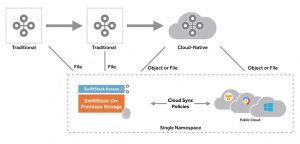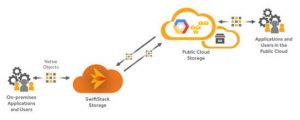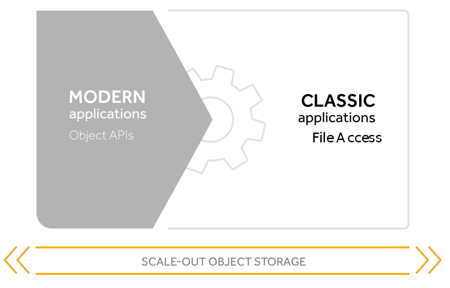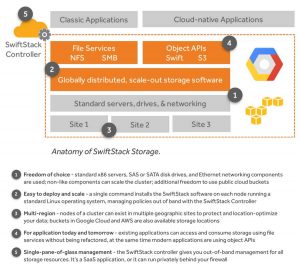SwiftStack 6 With Universal Access for Classic and Cloud-Native Applications to Single Namespace
Cloud-native storage on-premises and across public clouds enables freedom of mobility and scale for new and classic data-centric applications.
This is a Press Release edited by StorageNewsletter.com on December 14, 2017 at 2:27 pmSwiftStack, Inc. announced the availability of Universal Access for classic and cloud-native applications in SwiftStack 6.
Click to enlarge

Building upon several product updates in 2017, the company’s multi-cloud data management offering delivers a cloud-native, single namespace for unstructured data. Classic data-centric applications that use file protocols can leverage the benefits of the firm’s solution, without the need for refactoring. This file access combined with Cloud Sync enables policy-based data placement, giving applications the freedom to run wherever IT deems the workload can run best, and without altering the user experience, all while maintaining governance and control.
Cloud Sync
“In an IT future that’s becoming increasingly hybrid, the next phase of storage depends on the ability to manage data that will need to exist in multiple locations; both on and off-premises. Multi-cloud capable data management based on cloud-native technology can provide the framework, tools and resources necessary to deliver highly-available business data on a worldwide level,” said Steven Hill, senior analyst, storage technologies, 451 Research. “Traditional SAN and NAS systems will continue to maintain a role for the foreseeable future, but evolved and intelligent secondary storage-that’s capable of a deeper understanding of the value and relative importance of the information it protects-will become crucial to provide the policy-based data protection, automation, security, availability, cost-efficiency and granular lifecycle management needed to meet the challenges of next-generation business applications.“
SwiftStack 6 introduces integrated File Access. Applications and users can use SMB and/or NFS file access protocols to read and write to the single namespace, without a gateway. An distinction of File Access is that data can be read and written in both formats. For example, ingest data via file, read via object, and distribute via file, and vice versa. Universal Access including Cloud Sync extends this capability of accessing unstructured data from any cloud location independent of the access method required by the user or application.
“As we did with other SwiftStack innovations like Cloud Sync in 2017, version 6 with Universal Access was developed while directly collaborating with our installed customers to scale their environments and to extract new value from their data,” said Don Jaworski, CEO, SwiftStack. “Hundreds of IT professionals and executives validated the need to manage data across multiple public clouds to prevent lock-in at AWS re:Invent in Las Vegas, NV, and version 6 ushers in a new chapter for SwiftStack, having grown beyond on-premises object storage to genuine multi-cloud data management that supports the cloud-first business initiatives that IT has been tasked with for 2018 and beyond.“
Click to enlarge
The company brings the consumption experience and fundamental attributes of public cloud storage to enterprises: scalability, agility, elasticity, and pricing based on consumption. Legacy applications with large unstructured data sets can now access and consume the same data from a single namespace via file protocols without the need for a gateway or application refactoring. Unlike other object storage products that have their own proprietary data formats, data managed by the firm is always stored in cloud-native format. Policy-based data placement combined with Cloud Sync opens opportunities to scale on-premises file workloads in IaaS providers including Amazon Web Services and Google Cloud Platform. Whether on-premises or in public cloud, data remains under the management control of internal IT, residing wherever it is needed by users and applications.
Comments
Reading this last press release, the company changed its message from "a company that powers cloud storage for enterprises" in the October 31 press release to "the leader in Multi-Cloud Data Management" in the last one published in December 5.
Recently Mario Blandini, VP marketing, confirmed the wish to "be considered as a software company and not as an object storage company", confirming the difficulty all these vendors face with their object storage identity with the desire to be seen as data management players. SwiftStack is a software-sefined storage company, no doubt, even if the term is not present in the PR.
Multi-Cloud seems to be the new direction for object storage as vendors have some difficulties to deliver their original mission with the obligation now to extend their model. We remember the various target use cases they planned and the current reality with a reduced scope of solutions. It’s just a market fact, object storage became less attractive for users in 2017.
All players recognize also the superiority of file access wishing to offer their own access method as applications consume data as files for the vast majority of them finally.
Multi-Cloud Data Management (MCDM) is a new illustration of the lack of differentiators between vendors. If we hide the product and option names, we’re pretty sure readers and users can name several products to reflect these features, as they’re so similar between players.
SwiftStack introduces interesting capabilities with CloudSync and File Access that invite us to make a pause and read carefully the announcement. It reminds what the company announced during OpenStack conference in May 2016 with ProxyFS and we anticipated at that time the usage of some Maldivica IP acquired mid-2014.
So is it really new? In fact access to the same content from file and object protocols is not new if you consider one local pool of data as other vendors already offer this, but the multi pool with multi cloud and native data format preservation make this attractive with a special attention to data consistency, synchronization and integrity. So CloudSync details are key here.
We're surprised to see that object storage vendors finally offer a 'basic' data storage platform and many of them are poor in term of data services. As object storage is a capacity play and especially dedicated to secondary storage with backup, archiving … use cases, users expect and are looking for data (disk) reduction techniques (compression, deduplication and erasure coding as well with their interesting storage ratio) and energy savings. Try to list object storage vendors who offer these and you will be surprised of their weaknesses with some others will appear surprisingly in that list.
And finally we heard that some vendors ambition to raise money again, what a failure, with a new dilution and reduced exit multiple.

















 Subscribe to our free daily newsletter
Subscribe to our free daily newsletter

